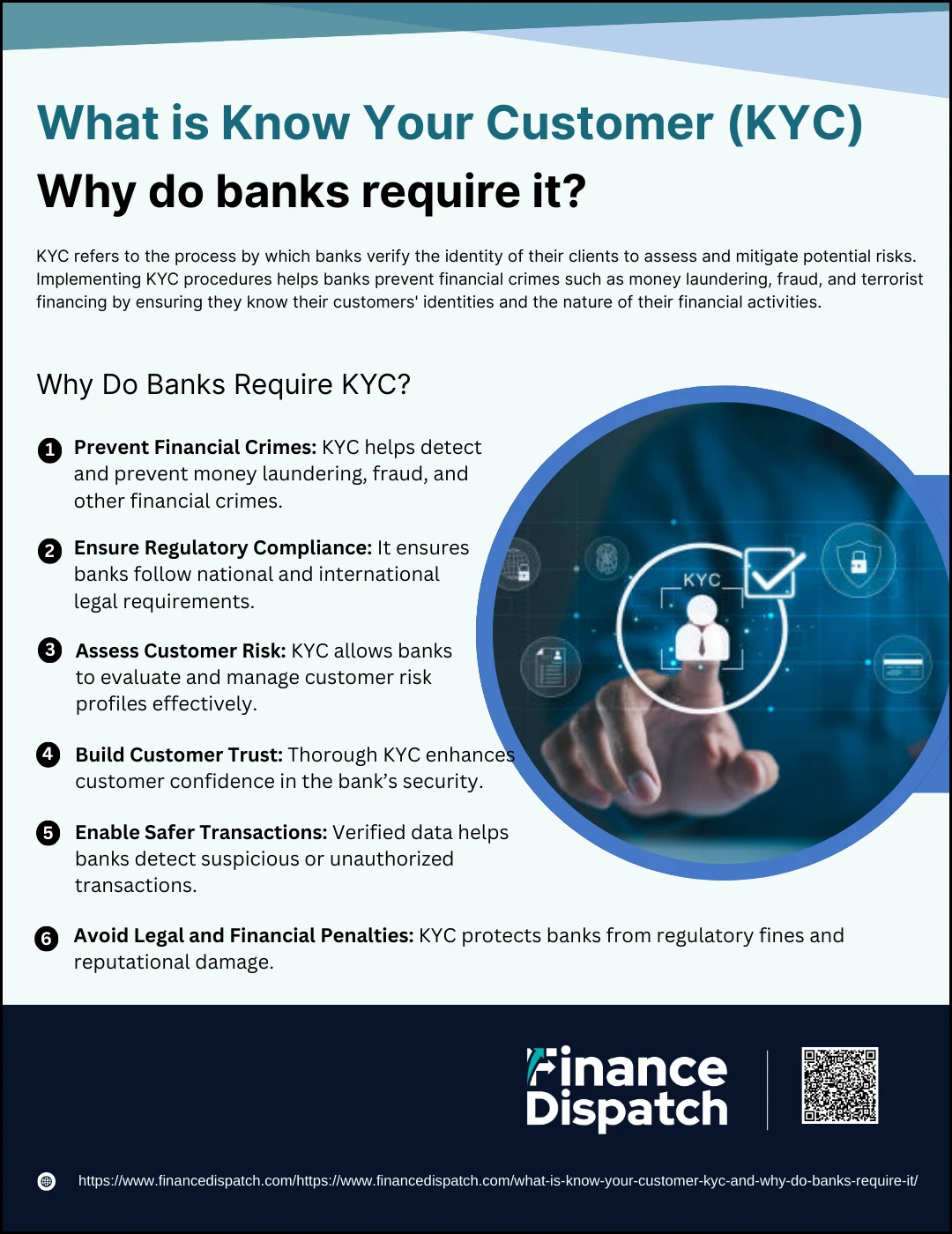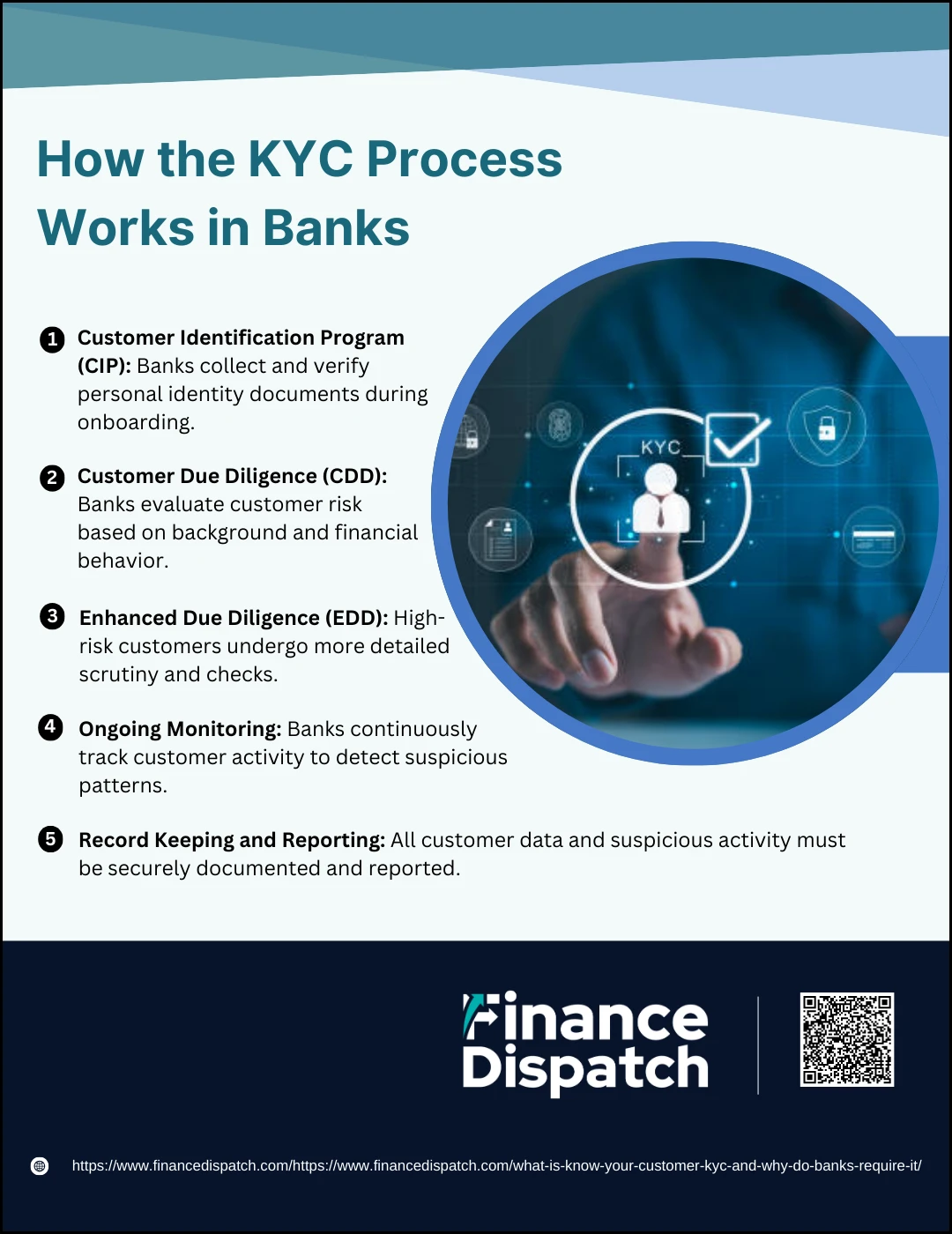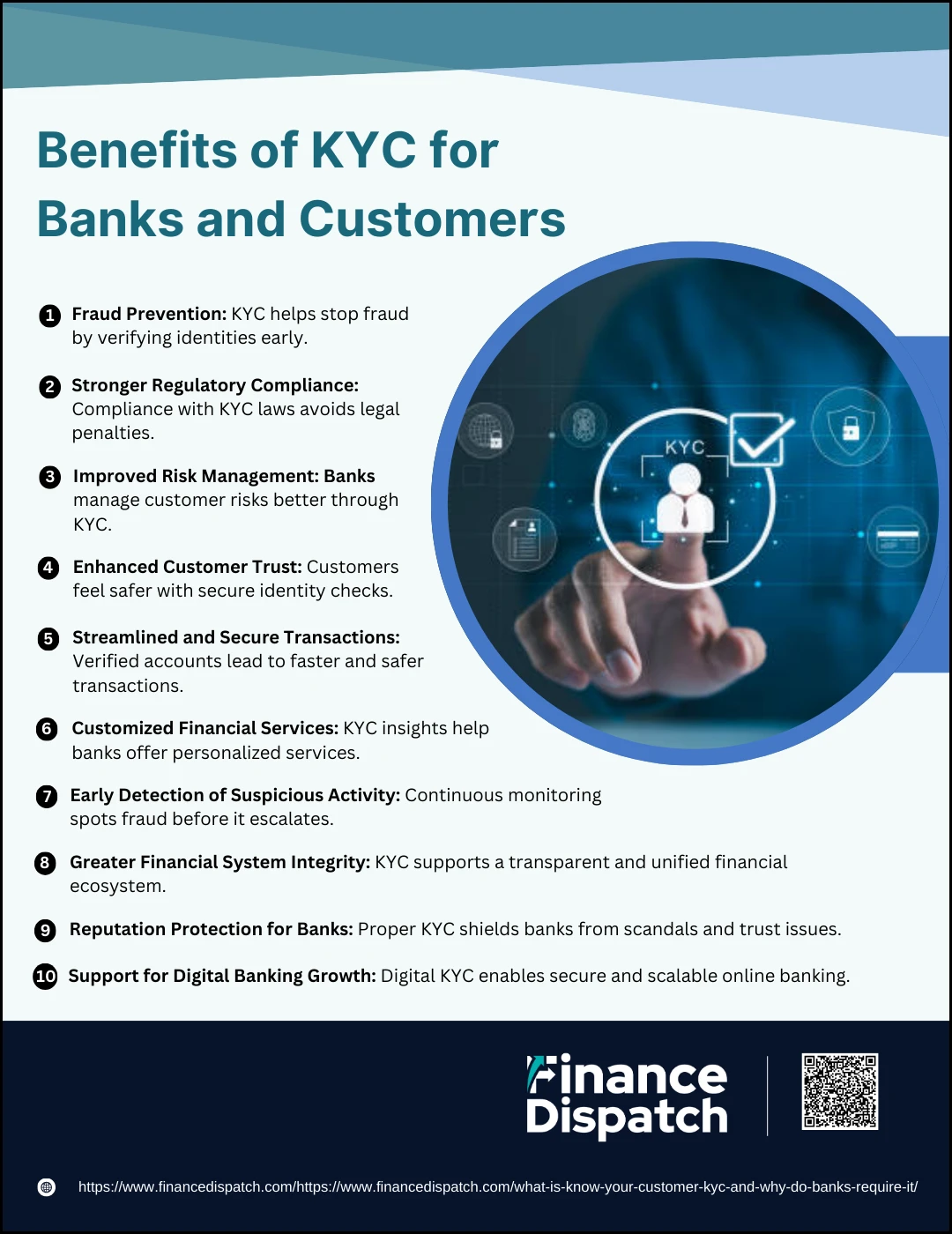In today’s increasingly digital and interconnected financial world, trust and transparency are more vital than ever. That’s where Know Your Customer (KYC) steps in—a crucial process that banks and financial institutions use to verify the identity of their clients and assess potential risks. Far more than just a regulatory checkbox, KYC serves as a protective shield against fraud, money laundering, and terrorism financing. By ensuring they truly know who their customers are, banks not only comply with international legal requirements but also foster safer, more secure financial environments for everyone involved.
What is Know Your Customer (KYC)?
Know Your Customer (KYC) is a mandatory process used by banks and financial institutions to verify the identity of their customers and assess potential risks associated with establishing a financial relationship. This process involves collecting personal information—such as name, date of birth, address, and government-issued identification—and ensuring that the customer is who they claim to be. KYC is not a one-time event; it begins at the time of account opening and continues throughout the customer’s relationship with the institution. By implementing KYC procedures, banks aim to prevent financial crimes like money laundering, identity theft, and terrorist financing while ensuring compliance with regulatory standards.
Key Components of KYC
The Know Your Customer (KYC) process is built on a structured framework designed to identify customers, evaluate their risk levels, and monitor their financial activities over time. These components ensure that banks and financial institutions operate within legal boundaries while protecting the system from misuse. Understanding each part of this process is essential to grasp how KYC works in practice.
1. Customer Identification Program (CIP): Verifies the customer’s identity using documents like government-issued IDs, proof of address, and other personal data before opening an account.
2. Customer Due Diligence (CDD): Involves collecting detailed information to understand the customer’s financial behavior, assess risks, and ensure they are not involved in illegal activities.
3. Enhanced Due Diligence (EDD): Applied to high-risk customers, this step includes additional checks such as deeper background verification, source of funds analysis, and adverse media screening.
4. Ongoing Monitoring: Continuous review of customer transactions to detect suspicious behavior, large or unusual transfers, and any changes in risk profiles.
5. Record Keeping: Maintaining updated and accurate customer data, including transaction histories and verification documents, to support compliance and audits.
 Why Do Banks Require KYC?
Why Do Banks Require KYC?
Banks require Know Your Customer (KYC) procedures not just as a formality, but as a vital part of ensuring the safety, legality, and trustworthiness of their financial services. By thoroughly verifying who their customers are and understanding their financial behavior, banks protect themselves—and the broader economy—from misuse, fraud, and regulatory violations. Here’s a closer look at why KYC is so essential for banks:
1. Prevent Financial Crimes
KYC acts as a frontline defense against financial crimes such as money laundering, terrorist financing, identity theft, and fraud. By verifying a customer’s identity and monitoring their transactions, banks can detect suspicious patterns or behaviors early and take necessary action. This protects the integrity of the financial system and helps law enforcement track and stop illicit activity.
2. Ensure Regulatory Compliance
Governments around the world mandate KYC through legislation like the USA PATRIOT Act in the U.S. and Anti-Money Laundering Directives (AMLD) in the EU. Banks are legally obligated to adhere to these regulations. Failure to comply can result in severe financial penalties, legal consequences, and even the revocation of licenses. KYC ensures that banks stay within the bounds of national and international financial laws.
3. Assess Customer Risk
Not all customers pose the same level of risk. KYC helps banks categorize clients based on their risk profile by analyzing factors like occupation, geography, source of funds, and transaction types. High-risk customers, such as politically exposed persons (PEPs) or individuals in sanctioned regions, require enhanced scrutiny. Risk assessment helps banks tailor their monitoring and prevent exposure to potential threats.
4. Build Customer Trust
When a bank implements a thorough KYC process, it signals to customers that the institution is committed to maintaining a secure and trustworthy environment. Customers are more likely to feel confident doing business with banks that prioritize identity verification and fraud prevention. This trust helps foster long-term relationships and brand loyalty.
5. Enable Safer Transactions
With accurate and verified customer data, banks can process financial transactions more securely. Knowing the customer’s profile allows the bank to flag inconsistencies, such as sudden large transfers or unusual international activity. This reduces the chances of financial losses due to unauthorized or fraudulent transactions.
6. Avoid Legal and Financial Penalties
Regulatory bodies impose hefty fines on institutions that fail to implement or maintain effective KYC procedures. Beyond the immediate financial impact, such failures can lead to reputational damage, shareholder distrust, and even sanctions that prevent the bank from operating in certain markets. Proper KYC is not just a best practice—it’s a critical safeguard against legal risk.
 How the KYC Process Works in Banks
How the KYC Process Works in Banks
The Know Your Customer (KYC) process in banks is a structured and ongoing system designed to verify customer identities, evaluate risk, and monitor financial activities. It starts when a new client seeks to open an account and continues throughout the entire relationship between the bank and the customer. The aim is to ensure that the bank fully understands who its clients are and to spot any red flags that may indicate fraudulent or criminal behavior. Here’s how the process typically unfolds:
1. Customer Identification Program (CIP)
This is the first and most crucial step, where the bank collects and verifies the customer’s identity information. Customers are required to provide documents such as a government-issued ID, proof of address, date of birth, and a national identification number. This step ensures the individual is who they claim to be.
2. Customer Due Diligence (CDD)
Once identification is complete, banks assess the customer’s risk profile by analyzing their financial background, occupation, and expected account activity. The purpose of this step is to understand the nature of the relationship and to establish a risk rating that will guide future monitoring efforts.
3. Enhanced Due Diligence (EDD)
For customers considered high-risk—such as those from high-risk countries, politically exposed persons (PEPs), or those dealing in large cash transactions—banks apply a more detailed and rigorous review. This may involve verifying the source of funds, reviewing business relationships, and checking global watchlists.
4. Ongoing Monitoring
KYC is not a one-time process. Banks must continuously monitor customer activity to detect unusual or suspicious transactions. This includes periodic reviews, real-time transaction tracking, and updates to customer profiles when new information becomes available.
5. Record Keeping and Reporting
Throughout the process, banks are required to maintain detailed records of customer information, verification steps, and transaction histories. If any suspicious activity is detected, banks must report it to the appropriate regulatory authorities, such as by filing a Suspicious Activity Report (SAR).
Documents Commonly Required for KYC
To comply with Know Your Customer (KYC) regulations, banks require specific documents that help verify a customer’s identity, address, and financial profile. These documents vary slightly depending on regional regulations and the risk level of the customer, but generally fall into three main categories: proof of identity, proof of address, and proof of income (especially in high-risk cases). Below is a table summarizing the most commonly accepted documents under each category:
| Document Category | Examples of Accepted Documents |
| Proof of Identity | Passport, Driver’s License, National ID Card, Voter ID, Residence Visa or Work Permit |
| Proof of Address | Utility Bill, Bank Statement, Rental Agreement, Property Tax Bill |
| Proof of Income (EDD) | Salary Slips, Tax Returns, Bank Statements, Employment Letter |
| Photographic Evidence | Passport-size Photo, Selfie with ID (for digital verification) |
| Business Documents (KYB) | Business License, Articles of Incorporation, Partnership Agreement, UBO Identification Documents |
Digital KYC: The New Era
As banking continues to evolve in the digital age, traditional Know Your Customer (KYC) processes are being transformed by technology. Digital KYC leverages tools such as biometrics, artificial intelligence (AI), and online document verification to streamline identity checks and reduce onboarding time. It enables banks to perform secure, remote verification while maintaining compliance with regulatory requirements—making the process faster, more accurate, and customer-friendly. Here’s how digital KYC is reshaping the future of banking:
1. Biometric Verification: Uses facial recognition, fingerprints, or iris scans to authenticate identity securely and instantly.
2. AI and Machine Learning: Automates data analysis to detect fraudulent patterns, reduce false positives, and assess risk profiles in real-time.
3. e-KYC Portals: Allow customers to submit documents and complete verification entirely online, reducing the need for physical visits.
4. Liveness Detection: Ensures that the person verifying identity is present and not using a photo or video recording.
5. Integration with Government Databases: Enables real-time validation of identification documents and cross-verification with official records.
6. Reduced Onboarding Time: Cuts down the customer verification process from days to minutes, improving user experience.
7. Enhanced Security: Protects sensitive data through encryption and secure storage methods, reducing risks of identity theft and fraud.
8. Scalability and Cost Efficiency: Supports high volumes of verifications with minimal human intervention, lowering operational costs.
KYC vs AML: What’s the Difference?
Know Your Customer (KYC) and Anti-Money Laundering (AML) are often mentioned together in financial regulations, and while they are closely related, they serve distinct purposes. KYC is a specific process within the broader AML framework. It focuses on identifying and verifying customers to understand who they are, while AML encompasses a wider range of policies and practices aimed at detecting, preventing, and reporting suspicious financial activities. Understanding the difference between KYC and AML is essential for banks to build comprehensive compliance programs. Here’s a comparison of both:
| Aspect | KYC (Know Your Customer) | AML (Anti-Money Laundering) |
| Definition | A customer verification process to confirm identity and assess risk | A broader legal framework to detect and prevent money laundering |
| Scope | Part of AML; focused on onboarding and customer verification | Encompasses KYC plus transaction monitoring, reporting, and training |
| Primary Goal | Know who the customer is and assess their risk | Detect, prevent, and report financial crimes like money laundering |
| Key Activities | Identity checks, due diligence, ongoing monitoring | Suspicious activity reporting, sanctions screening, regulatory audits |
| Tools Used | ID verification, biometric checks, document validation | Transaction analysis, AI-based monitoring, regulatory reporting tools |
| Timing | Primarily at onboarding and periodically thereafter | Continuous throughout customer lifecycle and beyond |
| Regulations | CIP, CDD, EDD (e.g., under the USA PATRIOT Act) | BSA, FATF recommendations, AMLDs, and local AML laws |
 Challenges in Implementing KYC
Challenges in Implementing KYC
Although Know Your Customer (KYC) regulations are vital for ensuring transparency and reducing financial crime, their implementation poses a range of operational, technological, and customer-facing challenges. For banks, especially those operating in multiple regions, establishing a seamless yet compliant KYC process involves juggling regulations, managing costs, and maintaining user experience—all while preventing fraud. Below are the most pressing challenges banks encounter during KYC implementation:
1. Changing Regulatory Requirements
Regulatory landscapes are constantly evolving. New rules from local governments and international bodies like FATF, FinCEN, or the EU’s AMLDs require banks to continuously update their compliance frameworks. Failure to keep pace can result in non-compliance, fines, or reputational damage.
2. Manual and Time-Consuming Processes
Traditional KYC methods often rely on manual reviews of documents, handwritten forms, and in-person verification. These not only slow down onboarding but also increase the risk of delays, lost data, and human errors.
3. Customer Experience Friction
Overly complex or lengthy KYC procedures can create frustration for new customers. They may abandon the process entirely or switch to competitors offering faster, more user-friendly onboarding—especially in digital banking.
4. Data Quality and Verification Issues
Inaccurate, incomplete, or outdated customer information can disrupt the verification process. Banks must work to ensure that all data collected is current and valid while protecting against forged or manipulated documents.
5. High Operational Costs
Implementing and maintaining a compliant KYC system requires investments in software, third-party verifications, trained staff, and regular audits. These costs can add up quickly, particularly for smaller financial institutions.
6. False Positives in Monitoring
Automated KYC and AML systems are designed to detect suspicious activity, but they often generate numerous false alarms. Investigating these false positives diverts compliance resources and delays responses to real threats.
7. Technology Integration Challenges
Many banks still operate on legacy IT systems that are difficult to integrate with modern KYC tools. Upgrading or replacing infrastructure to accommodate automation and biometric verification can be disruptive and resource-intensive.
8. Cross-Border Compliance
For global banks, complying with multiple jurisdictions’ KYC and data privacy laws is challenging. Each region may have different document standards, risk tolerances, or data retention rules, complicating efforts to create a unified process.
9. Remote Onboarding Risks
As digital banking rises, remote KYC processes are becoming standard. However, without physical interaction, verifying identities becomes harder. Fraudsters may use deepfakes, stolen identities, or fabricated documents to bypass checks.
10. Data Privacy and Security Concerns
KYC requires banks to collect and store sensitive personal data, making them targets for cybercriminals. Ensuring this information is protected with strong encryption and secure systems is essential for regulatory compliance and customer trust.
 Benefits of KYC for Banks and Customers
Benefits of KYC for Banks and Customers
Know Your Customer (KYC) isn’t just about ticking regulatory boxes—it’s a strategic tool that brings significant advantages to both banks and their clients. For financial institutions, KYC safeguards operations, supports compliance, and protects their reputation. For customers, it ensures a safer banking environment and enables better, more personalized service. Together, these benefits help foster trust, reduce financial crime, and promote a more stable and efficient banking system.
1. Fraud Prevention
KYC helps banks detect and prevent fraudulent behavior by verifying customer identities during onboarding and throughout the account lifecycle. This ensures that criminals using fake or stolen identities are stopped early, reducing risks of account takeovers, financial fraud, and unauthorized transactions.
2. Stronger Regulatory Compliance
Adhering to KYC standards ensures that banks meet the legal requirements set by global and national regulatory bodies. Compliance with these standards helps avoid regulatory scrutiny, hefty fines, and potential legal action that could harm the bank’s operations and reputation.
3. Improved Risk Management
Through detailed due diligence and ongoing monitoring, banks can assess the risk associated with each customer. This allows them to segment customers into low, medium, or high-risk categories and apply appropriate controls, such as enhanced due diligence for high-risk individuals or businesses.
4. Enhanced Customer Trust
Customers are more likely to trust banks that prioritize safety and due diligence. Knowing their personal information is handled responsibly and that the bank has systems in place to prevent fraud creates a sense of security and reliability.
5. Streamlined and Secure Transactions
Once customers are verified, their transactions can be processed more efficiently. With verified data, banks can minimize delays, reduce manual reviews, and flag unusual activity more effectively—enhancing the speed and security of financial operations.
6. Customized Financial Services
KYC enables banks to better understand a customer’s financial background, preferences, and behavior. This information allows them to offer personalized banking products and services, such as tailored loans, credit limits, or investment recommendations, leading to a better customer experience.
7. Early Detection of Suspicious Activity
Continuous monitoring of customer accounts enables banks to identify anomalies such as sudden large transfers, transactions in high-risk regions, or frequent changes in customer behavior. Early detection helps mitigate risk and protect both the bank and its customers.
8. Greater Financial System Integrity
Widespread implementation of KYC contributes to the transparency and integrity of the financial system. By ensuring that all institutions follow the same standards, it becomes harder for criminals to exploit gaps between jurisdictions.
9. Reputation Protection for Banks
Banks associated with financial crimes often suffer long-term damage to their brand and public trust. A robust KYC framework helps shield institutions from scandals involving money laundering or terrorism financing by ensuring that only legitimate customers are served.
10. Support for Digital Banking Growth
With the rise of online banking, digital KYC makes it possible to onboard and verify customers remotely in a secure, fast, and compliant manner. This opens the door for banks to expand their reach, reduce physical infrastructure costs, and meet the expectations of tech-savvy users.
Conclusion
Know Your Customer (KYC) is more than a compliance obligation—it’s a foundational element in the modern banking ecosystem. By verifying customer identities, assessing risk, and monitoring activity, KYC protects both financial institutions and their customers from fraud, money laundering, and other financial crimes. While implementing KYC can come with challenges, the benefits far outweigh the difficulties, offering stronger security, improved customer relationships, and enhanced operational efficiency. As digital transformation continues to reshape the banking sector, robust and adaptable KYC processes will remain critical to building trust, ensuring transparency, and maintaining the integrity of the global financial system.



